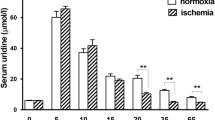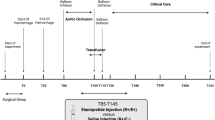Summary
This study was performed to examine potential protective effects of UK 38.485, an inhibitor of thromboxane synthetase, in canine myocardium stressed by transient ischemia.
On anesthetized open-chest mongrel-dogs (n = 9) repeated ischemia (3 min) was produced by proximal, intermittent occlusion of the left anterior descending artery. A total of 18 occlusions after 3 mg UK 38.485/kg body wt. and 12 occlusions after 5 mg UK 38.485/kg body wt. were compared to a total of 24 occlusions under control conditions. In each experiment, 2–3 control occlusions and 3–4 therapy occlusions were performed.
The drug was applied i.v. in a dose of 3 or 5 mg/body wt. 30 min before the first therapy occlusion. In both groups, hemodynamics and energetics did not significantly change as compared to control.
The efficiency of the drug in protecting ischemically stressed myocardium was examined by (a) quantification of oxygen debt and oxygen repayment in the occlusion and reperfusion periods and (b) the amounts of inorganic phosphate, lactate, and potassium released in the first minute of reperfusion. Compared to control occlusions, premedication with either 3 or 5 mg UK 38.485 led to a significantly reduced oxygen debt combined with a significant decrease of the release of inorganic phosphate, lactate, and potassium. The protective effect is suggested to be mainly due to enhanced flow to ischemic areas.
Data obtained in this study suggest protective effects of the compound in the preservation of myocardium in transient ischemia and attest to the concept that thromboxane A2 may aggravate the metabolic and energetic situation of myocardium in circumstances with reduced oxygen supply.
Similar content being viewed by others
References
Baller D, Bretschneider HJ, Hellige G (1979) Validity of myocardial oxygen consumption parameters. Clin Cardiol 2:317–327
Bergman G, Daly R, Atkinson L, Rothman M, Richardson PJ, Jackson G (1981) Prostacyclin: Haemodynamic and metabolic effects in patients with coronary artery disease. Lancet 1:569–572
Burke S, Lefer AM, Smith GM, Smith B (1983) Prevention of extension of ischemic damage following acute myocardial ischemia by dazoxiben, a new thromboxane synthetase inhibitor. Br J Clin Pharmacol 15:97S-101S
Chiercha S, deCaterina R, Brunelli C, Crea F, Patrono C, Maseri A (1980) Low dose aspirin prevents thromboxane synthesis by platelets but not attacks of Prinzmetal angina. Circulation 62 [Suppl 3]:215
Coker S, Parratt JR, Ledingham IA, Zeitlin I (1981) Thromboxane and prostacyclin release from ischemic myocardium in relation to arrhythmias. Nature 291:323–324
Coker S, Parratt JR (1983) Effects of dazoxiben on arrhythmias and ventricular fibrillation induced by coronary artery occlusion and reperfusion in anaesthetised greyhounds. Br J Clin Pharmacol 15:87S-95S
Dazoxiben—Clinical prospects for a thromboxane synthetase inhibitor (1983) Edinburgh, March 26–27, 1982. Br J Clin Pharmacol [Suppl 1] 15
Defreyn G, Deckmyn H, Vermylen J (1982) A thromboxane synthetase inhibitor reorients endoperoxide metabolism in whole blood towards prostacyclin and prostaglandin E2. Thromb Res 26:389–400
Fischer S, Struppler M, Böhlig B, Bernutz C, Wober W, Weber PC (1983) The influence of selective thromboxane synthetase inhibition with a novel imidazole derivative, UK 38.,485, on prostanoid formation in man. Circulation 68:821–826
Frishman WH, Christodolou J, Weksler B, Smithen C, Killip T, Scheidt S (1976) Aspirin in angina pectoris: effects on platelet aggregation, exercise tolerance and electrocardiographic manifestations of ischemia. Am Heart J 92:3–9
Hall RJC, Dewar HA (1981) Safety of coronary arterial prostacyclin infusion. Lancet 1:949–951
Harris DM, Greenberg R, Phillips MB, Osman GH, Antonaccio MJ (1980) Effect of SQ80, 338 (1-(3-phenyl-2-propenyl)-1H-imidazole) on thromboxane synthetase activity and arachidonic acid-induced platelet aggregation and bronchoconstriction. In: Samuelsson B, Ramwell PW, Paoletti R (eds) Advances in Prostaglandin and Thromboxane Research, vol 6. Raven Press, New York, pp 437–441
Hirsh PD, Hillis LD, Campbell WD, Firth BG, Willerson JT (1981) Release of prosta glandins and thromboxane into the coronary circulation in patients with ischemic heart disease. N Engl J Med 304:685–691
Hoeft A, Korb H, Baller D, Wolpers HG, Hellige G, Bretschneider HJ (1983) Quantification of ischemic stress during repeated coronary artery occlusion in the dog. A method for validation of therapeutic effects. I. Estimation of O2 dept and O2 repayment. Basic Res Cardiol 79:27–37
Jentzer JH, Sonnenblick EH, Kirk ES (1979) Coronary and systemic vasomotor effects of prostacyclin: Implication for ischemic myocardium. In: Vane JR, Bergström S (eds) Prostacyclin. Raven Press, New York, pp 323–336
Korb H, Hoeft A, Baller D, Wolpers HG, Hellige G, Bretschneider HJ (1983) Quantification of ischemic stress during repeated coronary artery occlusion in the dog. A method for validation of therapeutic effects. II. Reproducibility of the release and uptake of electrolyte and substrates. Basic Res Cardiol 79:38–48
Kuzuya T, Tada M, Ohmori M, Inui M, Inoue M, Abe H, Yamagishi M, Kodoma K (1980) Altered metabolism of thromboxane A2 and prostaglandin I2 in patients with angina pectoris. Circulation 64 [Suppl 3]:275
Lewy RI, Smith JB, Silver MJ, Saia J, Walinsky P, Wiener L (1979) Detection of thromboxane B2 in peripheral blood of patients with Prinzmetal's angina. Prostaglandins Med 2:243–248
Moncada JR, Bunting S, Mullane K, Thorogood P, Vane J (1977) Imidazole: A selective inhibitor of thromboxane synthetase. Prostaglandins 13:611–618
Moncada S, Vane JR (1979) Pharmacology and endogenous roles of prostaglandin endoperoxides, thromboxane A2, and prostacyclin. Pharmacol Rev 30:293–331
Needleman P, Wyche A, Raz A (1979) Platelet and blood vessel arachidonate metabolism and interactions. J Clin Invest 63:345–349
Neri-Serneri GG, Gensini GF, Abbate R, Mugnaini C, Favilla S, Brunelli C, Chierchia S, Parodi O (1981) Increased fibrinopeptide A formation and thromboxane A2 production in patients with ischemic heart disease: Relationship to coronary pathoanatomy, risk factors, and clinical manifestations. Am Heart J 101:187–193
Parry MJ, Randall MJ, Hawkeswood E, Cross PE, Dickinson RP (1983) Inhibition of thromboxane synthesis and enhanced production of prostacyclin in blood after treatment with selective thromboxane synthetase inhibitor UK 38.485. Br J Pharmacol 77:547–551
Preston FE, Whipps S, Jackson CA, French AJ, Wyld PJ, Stoddard CJ (1981) Inhibition of prostacyclin and platelet thromboxane A2 after low dose aspirin. N Engl J Med 304:76–79
Robertson RM, Robertson D, Roberts J (1981) Thromboxane A2 in vasotonic angina pectoris. Evidence from direct measurements and inhibitor trials. N Engl J Med 304:998–1003
Schrör K, Moncada S, Ubatuba FB, Vane JR (1978) Transformation of arachidonic acid and prostaglandin endoperoxides by the guinea pig heart. Formation of RCS and prostacyclin. Eur J Pharmacol 47:103–114
Schrör K, Smith EF, Bickerton M, Smith JB, Nicolaou KC, Magolda R, Lefer AM (1980) Preservation of the ischemic myocardium by pinane thromboxane. Am J Physiol 238:H87-H92
Smith EF, Lefer AM, Smith JB (1980) Influence of thromboxane inhibition on the severity of myocardial ischemia in cats. Can J Physiol Pharmacol 58:294–300
Szczecklik A, Gryglewski RJ (1981) Treatment of vascular disorders with prostacyclin. In: Lewis PJ, O'Grady J (eds) Clinical pharmacology of prostacyclin. Raven Press, New York, pp 159–167
Vermylen J, Deckmyn H (1983) Reorientation of prostaglandin endoperoxide metabolism by thromboxane synthetase inhibitor: In vitro and clinical observations. Br J Clin Pharmacol 15:17–22
Author information
Authors and Affiliations
Additional information
Supported by the Deutsche Forschungsgemeinschaft SFB 89 — Kardiologie Göttingen
Rights and permissions
About this article
Cite this article
Hoeft, A., Korb, H., Böck, J. et al. Preservation of myocardium in transient ischemia by the thromboxane synthetase inhibitor UK 38.485. Res. Exp. Med. 186, 35–46 (1986). https://doi.org/10.1007/BF01851832
Received:
Accepted:
Issue Date:
DOI: https://doi.org/10.1007/BF01851832




